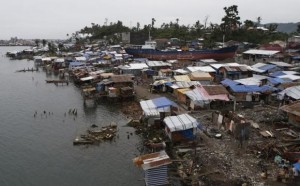
(Reuters) – Almost a year after a super typhoon devastated wide areas of the central Philippines killing thousands, President Benigno Aquino only this week approved a $3.74 billion master plan to rebuild housing, social services and public infrastructure.
Typhoon Haiyan wiped out or damaged practically everything in its path as it swept ashore on Nov. 8, 2013, with seven-metre storm surges destroying around 90 percent of the city of Tacloban in Leyte province.
Haiyan killed or left missing close to 8,000 people and displaced as many as four million.
The government has blamed the delays on bureaucracy, availability of land for resettlement and scarce resources.
“The national government’s commitment (is) to implement over 25,000 rehabilitation and recovery specific plans, programmes and activities,” Communications Secretary Herminio Coloma told reporters in Malacanang presidential palace on Thursday.
“The recovery plans are based on the principle of ‘build back better’ by focusing on long-term, sustainable efforts to reduce vulnerabilities and strengthen capacities of communities to cope with future hazard events.”
Apart from housing concerns, data from the Office of Presidential Assistant for Rehabilitation and Recovery showed the government had rebuilt only six km of 116 km of damaged major roads.
The data, as of September this year, shows the government has completed only six of 43 damaged ports, 213 of 19,600 classrooms, 21 of 161 civic centres and three of 34 bridges.
The government plan foresees more than 205,000 permanent houses being built for about four million people. The six-year plan was prepared in August but only signed on Wednesday.
The government has released about 51.9 billion pesos ($1.15 billion) for the initial recovery work but only 450 homes would be completed and ready for turn over to displaced families on Nov. 8, the first year anniversary of the typhoon.
About 75.6 billion pesos would be spent on new townships where homes, once built, would be able to withstand winds of 250 kph.
Alison Kent, Oxfam humanitarian policy adviser, said some administrative processes and land governance issues were to blame for delays in moving thousands of people from tents to permanent homes.
“We feel local authorities, right now, are struggling to find and acquire appropriate and safe land for resettlement sites,” she said.
Politics and corruption could also be reasons, said Rosario Bella Guzman, head of research of Ibon Foundation, an independent development agency.
“Some government agencies are saying that the fund releases from the government did not end up for what they were intended,” Guzman said.
(Reporting by Manuel Mogato; Editing by Nick Macfie)







